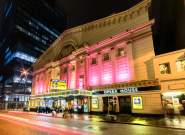Not even the War could stop the hard work of The Curtain Theatre, a Rochdale-based hub of creativity that has been putting on shows, without a break, for over 90 years. An example of hidden heritage at its finest, the building is tucked into a line of shops close to the train station – and offers an array of surprises within.

First established in 1925 as an amateur theatre by a group of local friends and relatives, The Curtain Theatre was a place determined to ‘open the door to culture’ in Rochdale – hence its symbol is a key, also suggesting the hidden aspect of the venue. Step inside and see ornate carpets complete with the key emblem, original furnishing… even a chandelier! It takes its name from the Elizabethan ‘Curtyn Theatre’ in London: one of the first places that Shakespeare’s plays were performed, before the likes of The Globe even existed. Indeed, in its early productions, sets were often fashioned from curtains.
On the inside, Rochdale’s Curtain Theatre is bigger than it looks – with the auditorium capable of holding an audience of 185, whilst a woodworking area and rooms for storage indicate the in-house effort that goes into every production… even the scenery is made on site! In 2018 alone shows included romantic chamber musical The Last Five Years featuring just two actors, as well as larger productions - a new version of Treasure Island being an example. An impressive variety of shows take place here: dramas, comedies, musicals and more.

In fact, delving into the extensive archive of plays produced at The Curtain Theatre reveals creativity across the decades – and tells us something about theatrical tastes over time too. Whilst its first ever year in 1925-26 included A Florentine Tragedy and Augustus in Search of a Father, by 1930 The Importance of Being Ernest had been staged. The 1930s seemed to contain some particularly Gothic highlights too including The Witch, Fear, Ghosts and The Wizard of Menlow.
Shows even continued during the years of World War Two (1939-45), with Coriolanus – Shakespeare’s tragedy detailing the downfall of a Roman General – playing to audiences in 1945 itself. Whilst the 1960s saw shows such as A View From the Bridge and The Glass Menagerie, the 80s showed no sign of momentum dropping; from the popular Dick Whittington And His Cat in 1980-1 to Entertaining Mister Sloane by 1989-90. Recent productions include Pinter and Ayckbourn plays, as well as fresh, contemporary material such as Di and Viv and Rose written by Amelia Bullmore and Hugh Janes’ mysterious The Haunting (set pictured below).
”A lot of local people are still not aware the theatre is here!” says Drama Director Peter Fitton. “Though people do trust us, and a few of the regular audience have been coming for over 60 years. I first got involved when I was in my twenties, and I’m now 64. I have been Drama Director for six years.”

Peter is stepping down in August, opening the opportunity to others. Creative opportunity is very important to the theatre, as Peter reflects:
“Celebrating local talent matters, as well as giving people a chance. Perhaps unusually, we have no formal auditions process – if I see someone in a production and think they have potential, I will try to get in touch: I have a little black book full of names and contacts!
“We are fortunate that amateur theatres in surrounding areas are still prospering, and I try and catch shows there when I can.”
For example, there is the nearby Oldham Lyceum, Playhouse 2 at Shaw and also the Saddleworth Players, an amateur dramatic society who meet in Delph at the Millgate Arts Centre.
The continuance of theatrical creativity in the boroughs allows for audiences to see a variety of performances – and The Curtain Theatre is remarkably prolific too. Still going strong, it now produces five interesting and unusual shows per year (see the image of 2016's Up 'n' Under below), with an impressive ten performances per show.

According to Peter:“The Curtain Theatre has continued to champion artistic creativity here in Rochdale, even at times of difficulty. For example, when Rochdale’s Theatre Royal burned down in 1954 – and considering the Gracie Fields Theatre wasn’t established until the late 1970s – Rochdale would have been without a theatre producing non-musical shows otherwise. Its history goes far beyond that too, as the Curtain Theatre actually started off in the 1920s, with the amateur dramatic society performing in a range of places, including the Drill Hall and the old Fire Station. It moved into the current building in the mid-1930s.”
At this time, the area where the theatre stands would have looked very different – a busy thoroughfare with a Co-op next door. Now, it could be seen as a little off the beaten track, slightly out of the town centre – but well within walking distance and certainly worth it. The building itself was originally the National Liberal Club for Castleton (the area of Rochdale), and a communal feel still exists in the place; with people helping out however they can. Many of the original customs continue, like Curtain Theatre members often helping with the wider running of the play, even Front of House!
“People do it for the love of it,” says Peter. “And we indeed have our regulars, but I’d love more young people to take part in the running of the theatre.” Pictured below: the set of Peggy For You (2017)

So how do you get involved? Rather unusually, potential members are asked to join a mailing list. They then receive notice of forthcoming productions and request tickets. At the theatre, patrons are requested to make a donation (currently suggested at £8). This means the theatre still largely operates on sending invites and receiving replies by post, although some tickets can now be purchased online. The good news is, anyone can sign up and be part.
“It might seem a bit of an unusual format, but it works for us,” adds Peter.
“It is quite quaint. I would love more young people to be part though and really it is as easy as signing up.”
The Curtain Theatre after all, celebrates personal involvement at its centre. Instead of a committee, it just has a Business Director - currently Lynn Sheerin - and the Drama Director, with a Trustees meeting, usually once a year. And if you are part of the mailing list, you are a member… it is that simple.
“Much of the regular audience are in their 60s, 70s and 80s… and they really matter to the theatre,” reflects Peter. “But it’s also important to get new people coming along too. Therefore, as Drama Director, I have tried to put on a combination of popular shows, as well as theatre that is a bit unusual and different… I’d like to think that people trust us and are willing to give us a chance.”

A recent example of the theatre’s wide-spanning creativity was a production of Hamlet (pictured above); one of Shakespeare’s darkest – and longest – plays.
“It was a challenge... but what struck me was how the cast – and they were quite a young cast – were determined to get on top of it. They really were in it for the love of it.”
Cutting the script to two and a half hours, Peter and the cast had an intense time of rehearsals before a ten-day run. After all, most productions here will have only six weeks rehearsal time, before going live to the audience. This means that even during the run itself, change and development is still ongoing. A chance to catch theatre at its most interesting and dynamic.
“I’ve loved the range of productions that have taken place here,” says Peter.
“An example of a play I was involved in earlier this year was called The Haunting by Hugh Janes: a ghostly story with Gothic horror elements. I wore a rather bizarre wig, hired from a company in Ancoats, there were intense sound effects – it really was quite creative! And we just keep hammering away! During my time as Drama Director there has been plenty of variety: the recent run of Macbeth, The Weir, The Steamie, A Taste of Honey, A Kind of Alaska (pictured below), The Game… as just a few examples!

But is the building haunted itself? Considering the place has such a long history and has seen many people pass through over the years, a few stories can perhaps be expected…
“Our former stage designer, who worked on the set and was often in the building at night on his own, said that he heard footsteps on the stairs on quite a few occasions, even though the place was completely empty,” says Peter.
“There have been various accounts, including that the theatre is perhaps being ‘revisited’ by an old Stage Manager from the 1950s. The theatre is a place of stories! Who knows, I’ll probably end up haunting it myself!”
Intrigued? Why not sign up to The Curtain Theatre invitation list to be an audience member or get involved in shows and unlock new opportunities for yourself. For those interested in either, the theatre can be contacted directly on 01706 642008 (answerphone but leave a message).
By Emily Oldfield
Photography: Production shots thanks to Michael Montgomery







